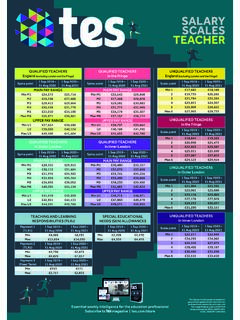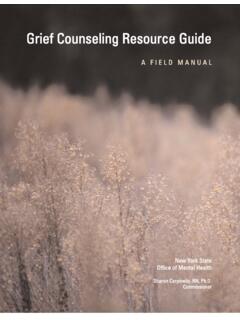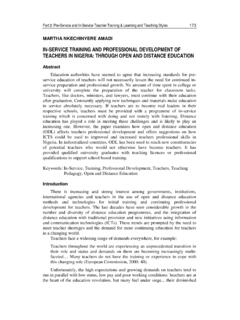Transcription of Teachers and the Teaching Profession in Sierra Leone
1 A Comprehensive Situation Analysis ofTeachers and the Teaching Profession in Sierra LeoneFinal report presented to theTeaching Service Commission Teaching Service Commission7 Priscilla StreetFreetown, Sierra LeoneTel: +232 (0)79 686 031 SERVICE COMMISSION, Sierra LEONEB etter Teachers , Stronger NationA COMPREHENSIVE SITUATION ANALYSIS OF Teachers AND THE Teaching Profession IN Sierra Leone Final report presented to the Teaching Service Commission February 2018 Project ID: P133070 Credit No.: TF16568 Submitted by:Dr. Cream Wright (consultant)This study was financed from funds provided by the Global Partnership for Education and administered by the World Bank, in support of the education sector in Sierra Leone . The views and opinions expressed in the study are those of the consultant and should not be interpreted as representing the position of the World Bank or the Global Partnership for ContentsAbbreviations ..4 Foreword ..5 Executive summary.
2 7 Part A Introduction and methodology ..13 Chapter 1: Background and introduction .. Background to the situation analysis .. Purpose, focus and context of the situation analysis .. A conceptual framework for understanding the study ..17 Chapter 2: Approach, methodology and data sources .. Outline of the general approach of the study .. Use of mixed methodology for actionable knowledge ..19 Part B Teachers by the numbers ..21 Chapter 3: teacher numbers and characteristics .. Overview of the current situation .. Profiles of the national Teaching force ..28 Chapter 4: Interventions on numbers and quality .. Investments in numbers and quality .. Pre-service education provisions .. Patterns of enrolment in teacher education courses .. In-service education and training provisions .. Provisions for continuous professional development ..42 Chapter 5: teacher supply and demand trends .. Trends in teacher numbers .. Trends in teacher recruitment .. Trends in teacher supply.
3 Trends in teacher quality ..47 Part C teacher development and management ..51 Chapter 6: Teachers issues and pre-occupations .. Overview of key issues and preoccupations ..51 Chapter 7: teacher quality and professionalism .. The quest for teacher quality .. Assessment of teacher quality .. A quality-oriented Teaching force .. Setting expectations for Teachers as professionals ..592 Chapter 8: Governance and Public-sector reform and teacher governance .. teacher management and support ..63 Chapter 9: teacher costs and affordability .. Structure and patterns of teacher remuneration .. The teacher salary bill in context ..67 Part D - Conclusions and recommendations ..69 Chapter 10: Key outcomes and action points .. Right-sizing the Teaching force .. Enhancing teacher quality and professionalism .. Investing in a quality-oriented Teaching force .. Managing an affordable Teaching force ..77 Bibliography ..78 TABLES, CHARTS AND FIGUREST able : teacher numbers disaggregated by level and gender.
4 22 Table : teacher numbers disaggregated by : Percentage of qualified Teachers by level of the education system ..24 Table : Pupil- teacher ratios by level of the education system ..25 Table : Pupil- teacher ratios by administrative : Payroll expenditures for Teachers and other : Number and per cent of Teachers by years of experience ..28 Table : Pupil- teacher ratios and gaps in PTR by education level ..29 Chart : Protracted genesis of the Teaching Service Commission ..14 Chart : TSC responsibilities in line with public-sector reform in Sierra Leone ..15 Chart : International goals and indicators for teacher policy ..18 Chart : Pre-service teacher education institutions and courses ..38 Chart : Policies and strategies on governance and management of Teachers ..62 Figure : Trends in distribution of Teachers (%) by qualification, 2010 2016 ..24 Figure : Average PTR for 2010 2016 ..29 Figure : PTR by education system level for 2010 : Average PQTR for 2010 comprehensive situation analysis of Teachers and the Teaching Profession in Sierra Leone3 Figure : Average PTR by administrative region, 2010 and 2016.
5 32 Figure : Percentage of female Teachers in primary level ..33 Figure : Percentage of female Teachers in secondary level ..34 Figure : Profile of Teachers years of experience, 2010 : Key components in the making of professional : teacher certificate programmes for Teaching at the pre-primary and primary levels, 2005 2016 ..39 Figure : Enrolment in TCL, TC or HTC (P) in Sierra Leone , by gender, 2005 2016 ..39 Figure : Enrolment in HTC secondary programmes in Sierra Leone , by gender, 2005 : Trends in number of Teachers by : Growth in teacher numbers by level of the education system ..43 Figure : Trends in per cent of Teachers by gender and level of the education system ..44 Figure : Percentage distribution of Teachers by years of experience ..45 Figure : Trends in graduation for teacher education courses by gender ..46 Figure : Trends in graduation from TLC, TC, and HTC (P) courses ..47 Figure : Trends in per cent of unqualified Teachers in the : Trends in per cent of Teachers by type of qualification.
6 48 Figure : Trends in per cent of primary level Teachers by type of : Trends in per cent of JSS Teachers by type of : Trends in per cent of SSS Teachers by type of : Essential teacher competencies for a high-quality Teaching force ..56 Figure : SABER criteria for assessing the quality of a Teaching : Western Area students performance at final school examinations (WASSCE)..58 Figure : Eastern Region students performance at final school examinations (WASSCE)..58 Figure : Essential elements of coherence for a high-quality Teaching force ..594 AbbreviationsASC Annual School CensusBECE Basic Education Certificate ExaminationCPD Comprehensive Professional DevelopmentEBKUST Ernest Bai Koroma University of Science and TechnologyESP Education Sector PlanFBC-USL Fourah Bay College University of Sierra LeoneFGDs Focus Group DiscussionsGPE Global Partnership for EducationHEC Home Economics CentersHTC (P) Higher Teachers Certificate (Primary)HTC (S) Higher Teachers Certificate (Secondary)JSS Junior Secondary School(s)MEST Ministry of Education, Science, and TechnologyMMCET Milton Margai College of Education & TechnologyOECD Organisation for European Co-operation and DevelopmentPIN Personal Identification NumberPRSP Poverty Reduction Strategy PlanPTR / PQTR Pupil- teacher Ratio / Pupil-Qualified- teacher RatioSABER Systems Approach for Better Education ResultsSDGs Sustainable Development GoalsSSS Senior Secondary School(s)
7 TALIS Teaching and Learning International SurveyTC Teachers CertificateTLC Teachers Lower CertificateTSC Teaching Service CommissionUIS UNESCO Institute of StatisticsUNESCO United Nations Educational Scientific and Cultural OrganisationUNICEF United Nations Children FundWASSCE West African Senior Secondary Certificate ExaminationA comprehensive situation analysis of Teachers and the Teaching Profession in Sierra Leone5 ForewordThe Teaching Service Commission (TSC) is pivotal to education reform in Sierra Leone . The system has been remarkably resilient in surviving the turbulence of eleven years of civil war, long periods of economic decline, and a more recent 2-year crisis due to the Ebola pandemic. These disruptive trends posed threats to the functioning, expansion, and quality of education. Despite such turbulence schools survived, Teachers persevered, and the education system achieved significant expansion. More than ever, more children are now enrolled and attending primary and junior secondary school in Sierra Leone .
8 This is in line with the national commitment to provide all children with access to nine years of quality basic education as a , it seems that such rapid expansion has been achieved at the expense of the quality and integrity of the education system. Performance of learners has declined, school standards have been eroded, allegations of malpractice are rampant, resources for Teaching and learning are scarce, funds for teacher salaries are in crisis, too many Teachers remain unqualified /untrained, the professional status of Teachers is being undermined, and public confidence in education has plummeted. The TSC must play its part in tackling these problems, with the full involvement of Teachers and cooperation of education officials. As Chair, I affirm that the TSC takes this challenge seriously. In line with our mandate we have developed professional standards for Teachers and managers. We are also working on mechanisms and guidelines for teacher policy development, as well as for teacher recruitment and management.
9 In addition to developing and rolling out such oversight and management tools, we need to better understand the situation of Teachers and the Teaching Profession , as a basis for designing major reform strategies and study describes and analyzes the situation of Teachers and the Teaching Profession in Sierra Leone and compares this with other African and developing countries. It covers pertinent issues such as governance, costs, and professional status; as well as teacher numbers disaggregated by gender, location, qualification, levels, experience, etc. Its findings and recommendations are couched in the context of national as well as global norms/standards; yielding implications for strategies to reform the Teaching Profession . It also reviews changing patterns and trends in the provisions for education and training of Teachers ; and what this implies for sustainable changes in the size, quality, and costs of an optimal national Teaching key focus of the study is on whether the current Teaching force is adequate and affordable, for Sierra Leone s educational needs, budgetary means, and development goals.
10 The report suggests a need to develop strategies for right-sizing the Teaching force, based on such factors as: too many Teachers in the system but too few qualified Teachers ; too many male Teachers compared to female Teachers ; dwindling numbers of committed long-term professionals; and inequitable deployment of qualified Teachers across districts. Such factors suggest that right-sizing strategies will involve: reducing total numbers whilst increasing percentage of qualified Teachers ; restoring gender balance; attracting and retaining committed professionals; and deploying qualified Teachers more equitably across the system. Foreword6 The goal of right-sizing should be to cultivate a good quality national Teaching force that is affordable and report contends that Sierra Leone cannot afford to support and maintain its current Teaching force, given the present and foreseeable fiscal realities. The study highlights two dimensions of affordability that must be addressed.




